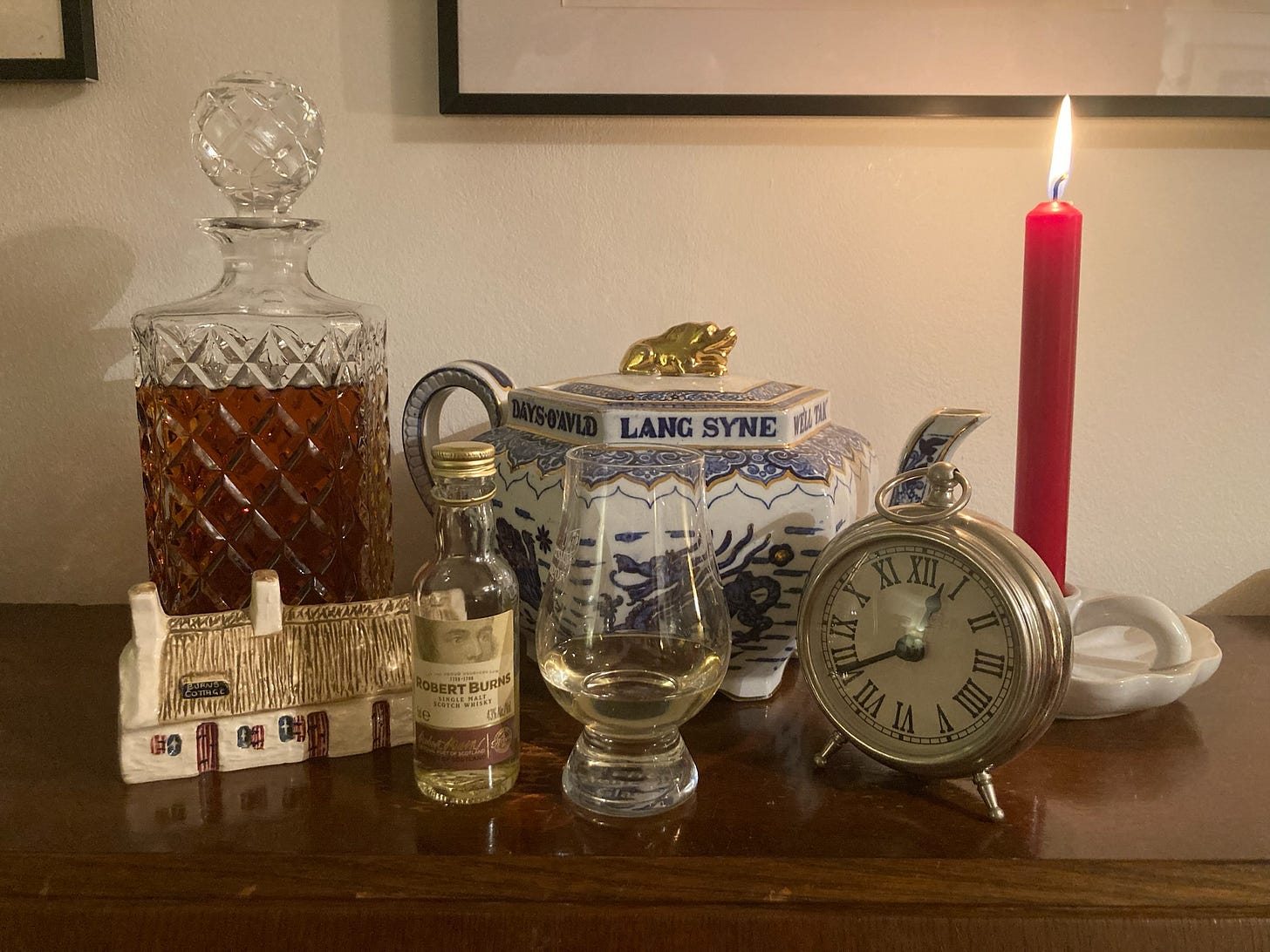Scotch whisky history in Robert Burns's poem 'Scotch Drink'
He wrote about whisky when the making and culture of Scotch whisky was changing
Robert Burns’s month
If you’re a Scotch whisky drinker active on social media your feeds may be inundated with Robert Burns references throughout January by your favourite whisky brands and accounts. Living in Scotland you certainly can’t escape the bard from Hogmanay (New Year’s Eve) singing Auld Lang Syne to Burns Suppers (for his birthday) with an Address to the Haggis. Which has put me in a silo of Burns mania. If you don’t have the privilege of living in Scotland you may be wondering why an 18th-century poet has been getting so much attention and what does it have to do with whisky?
There are some great sources I’ll link here to justify why Robert Burns is the national poet from The National Trust for Scotland and The History Press and a blog post about Burns and whisky but today I want to talk about points in his poem Scotch Drink that highlights significant changes emerging during his life for the making of Scotch whisky and the culture of the drink in Scotland.
Scotch Drink
Robert Burns has become associated with Scotch whisky and drinking culture through their inclusion in his poetry. His poems were widely inspired, by his education, and observations from politics and history, farming, and rural life. His familiarity with drink in local ale houses and inns is apparent in the folklore that has remained attached to these places and in the way he writes about them. He mentions drinking in poems such as The Jolly Beggars and Tam O’Shanter.
But, it’s Scotch Drink, which appears in his first published volume printed in 1786 in Kilmarnock, Poems Chiefly in the Scottish Dialect (linked here to a digitised copy in the National Library of Scotland). I won’t transcribe the whole poem so encourage you to have a read of it in companion to my comments. The poem was inspired by contemporary events, his writing reveals the significance of Scotch whisky in Scotland in the 18th century and the future he perceived from changing legislation.
The first few stanzas of the poem serve as an introduction to the subject. In the first stanza, Burns tells us that while other poets praise wine, instead he says, “I sing the juice Scotch bear can mak us, In glass or jug.”
Using the phrase “I sing” signals to readers that Burns is going to tell us about a significant subject. This demonstrates his education and familiarity with Virgil’s Aeneid, which famously begins with “I sing of arms and man” to tell the story of the Trojan War (the arms) and the journey of Aeneas (the man). It is an epic poem about the origins of the Roman people. In this way, Burns is taking on the mantel of Virgil to tell us about Scotch whisky, and I would argue he links the lineage of whisky making and Scotland, and what is to come in the poem, as a foundational myth akin to the Aeneid.
He uses the term “Scotch bear” which refers to barley grown in Scotland and is closely related to the word bere which today denotes a type of barley grown in the Highlands and Islands. It is an ancient grain that historians believe has been grown here since neolithic times.
The second stanza of the poem tells us how Scotch whisky inspires Burns and he describes the production of the spirit. “Whether thro’ wimpling worms thou jink, Or, richly brown, ream owre the brink, In glorious faem…” the “wimpling worms” refers to the distilling apparatus, and the “ream owre the brink” refers to the fermentation process before distilling.
To make whisky you take barley that has been through the malting process to activate the sugars inside the grain that are needed to convert to alcohol. Steeping the malted barley in hot water removes those sugars and effectively makes a sugary barley tea that when you add yeast will ferment to produce alcohol. The fermentation process is very active with the yeast bubbling to convert the sugar into alcohol which creates a foam that if you are not careful, will as Burns describes, foam over the edge of the vessel. This process is almost the same as making beer but to become whisky that beer must be distilled.
Burns describes the still as “wimpling worms” which refers to the part of the still that captures the spirit. The barley beer that has been made is put into the still in the shape of a pot or cauldron with a lid, it is then heated to evaporate the beer with the water and alcohol becoming vapour that rises to the top of the still, it then travels into the worm which has been cooled with water which turns the vapour back into liquid. Burns uses the words “wimple” and “jink” which describe the journey of the spirit as it meanders through the still worm and escapes to be collected.
The Water of Life
The poem continues for a further 19 stanzas, where Burns paints a picture of the role of whisky in Scottish culture. His rhymes illustrate how significant the spirit is in social life and that because of outside interference, this treasured produce was at risk. He criticises the taste that some had for foreign spirits referring to brandy as “burning trash”. While his experience of brandy was likely spirit which had been adulterated the real threat in Burns’s mind was the intervention in Scottish life from across the border. He wrote Scotch Drink, the winter after new legislation from Westminster was enacted in 1784 that made it illegal to distil whisky without a licence. Licences had previously only been required for commercial distilling with only a few of these operations established across Scotland. Distillation in Scotland had been regulated for centuries and for a time even stipulated the exclusive right to distil to the Barber Surgeons in Edinburgh in 1506. Yet, whisky flourished as an integral part of Scottish hospitality and celebration. In Burns’s time, small-scale distillation was regulated so that you could not sell the spirit you made at home and often was a part of domestic work with the produce shared with neighbours. This restriction to distilling in Burns’s mind was an attack on the people and a disruption of their heritage.
After the 1707 Act of Union, the government tried numerous times to intervene in the production of Scotch whisky but was met with resistance such as the 1725 Malt Tax riots in Glasgow. When Burns wrote the lines to Scotch Drink, it is possible his impassioned lament for whisky was inspired by the news of the closure of the Ferintosh distillery which was one of the few commercial distilleries and known by name, the most famous whisky made in Scotland. Ferintosh had flourished in part to their advantage to distil duty-free, granted by the government as recompense for the destruction of the previous distillery by Jacobite supporters following the landowner Duncan Forbes of Culloden’s support of the 1688 revolution. The government recalled the duty-free exemption with the 1784 Duties on Spirits Act, commonly called the Wash Act. This led to the distillery's closure, and despite an effort to modernise taxation on legal whisky making, it marked a period of rampant illicit distilling across Scotland.
The end of the Ferintosh distillery, for Burns, signalled the tragic decline of the potential for Scotch whisky and personified the experience of Scotland’s people desperately trying to scrape an income met with setbacks, death, and taxes. Something which Burns was very familiar with from a young age which saw his father endeavour to raise the family’s income through farming, and would later influence Burns’s efforts to train as a flax-dresser and to sell his written words. The tumultuous time in which Burns lived did not just impact the illicit activity for Scotland’s native drink, but smuggling and tax evasion reached a multitude of goods from sugar and tobacco to textiles and imported wines. This provided a perhaps surprising career for Burns in 1788, only a few years after his impassioned outcry at taxation, he took on the mantle of excisemen. His post was in Dumfries which sits on the Solway Firth which was a very popular route for smuggling as ships could sail up the firth and set their goods away into the Scottish borders and the North of England.
I think what I enjoy so much about his poem as a historian, is that Burns must have believed this was a historical moment too. I at least have the benefit of knowing what happened after. Despite Burns’ lament for Scotch whisky, the national drink did not meet its end, but it certainly did not remain the same. Subsequent 19th-century changes in licencing and distilling technology advancements contributed to the scale and scope of distilling activity emerging as an industry and along with his poems Scotch whisky has made its way around the world. That’s a story for another day!





